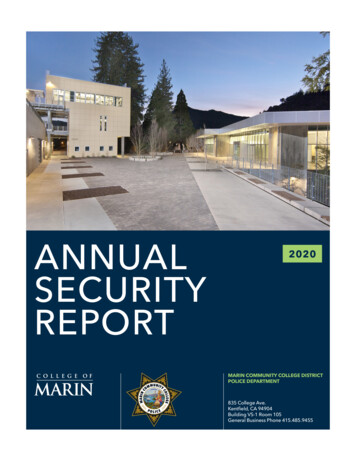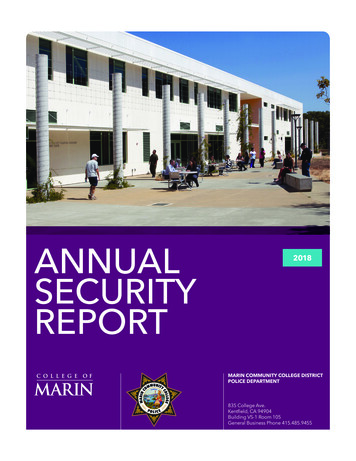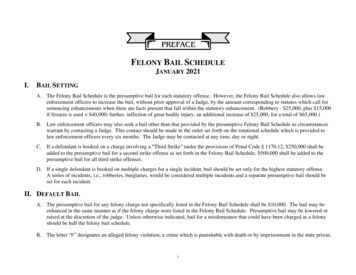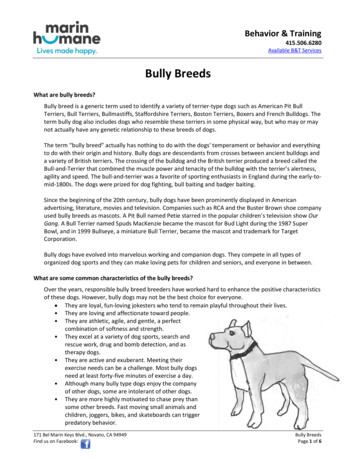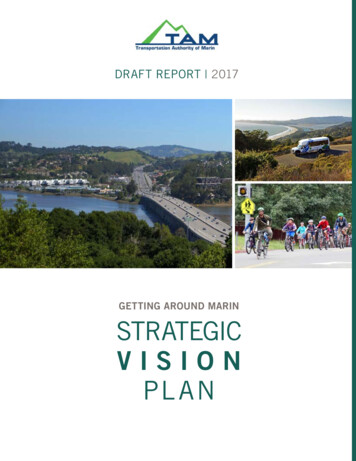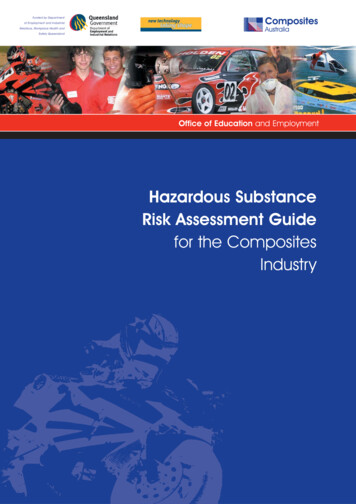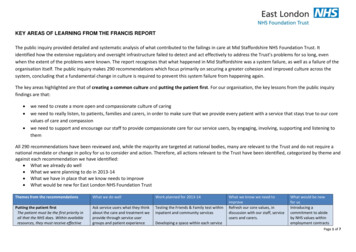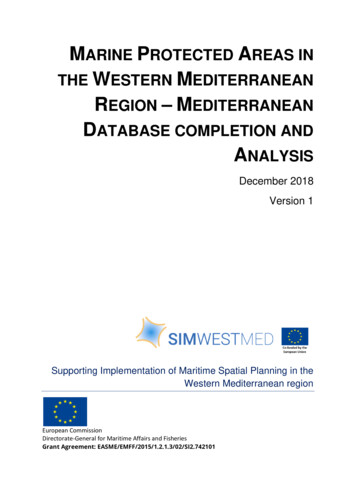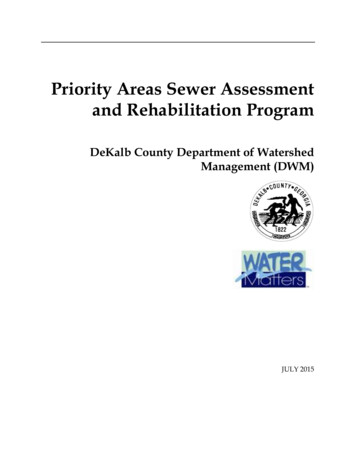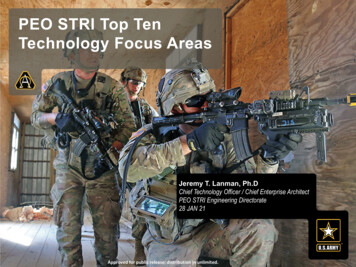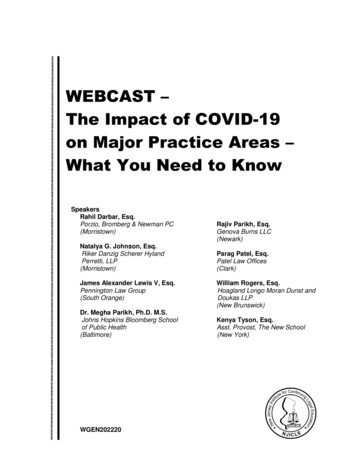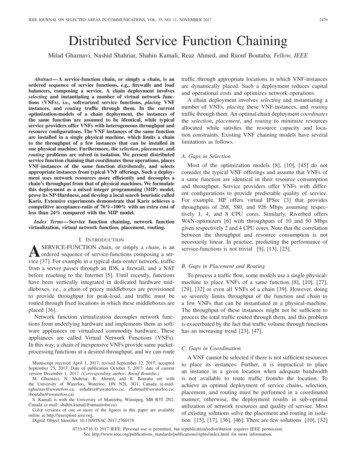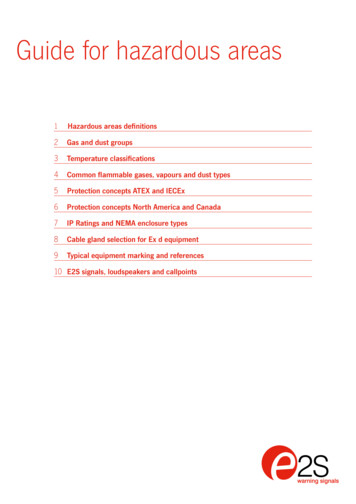
Transcription
Guide for hazardous areas1 Hazardous areas definitions2G as and dust groups3T emperature classifications4C ommon flammable gases, vapours and dust types5 Protection concepts ATEX and IECEx6P rotection concepts North America and Canada7I P Ratings and NEMA enclosure types8C able gland selection for Ex d equipment9T ypical equipment marking and references10 E 2S signals, loudspeakers and callpoints
Hazardous areas definitions1Hazardous areas according to ATEX and IECEx zonesHazardous locations according to North Americanclasses and divisionsZones - define the type of explosive atmosphere as well as thelikelihood of an explosive atmosphere being presentClasses - define the type of explosive atmosphere:0 - E xplosive gas atmosphere present continuously or for long periods1 - Explosive gas atmosphere likely to occur in normal operation2 - Explosive gas atmosphere not likely to occur in normal operationbut may be present for short periods20 - Explosive dust atmosphere present continuously or for long periods21 - Explosive dust atmosphere likely to occur in normal operation22 - Explosive dust atmosphere not likely to occur in normaloperation but may be present for short periodsI - A location made hazardous by the presence of flammable gasor vapor that may be present in the air in quantities sufficientto produce an explosive or ignitable mixtureII - A location made hazardous by the presence of combustible orelectrically conductive dustIII - A location made hazardous by the presence of easily ignitablefibers or flyings in the air, but not likely to be in suspension inquantities sufficient to produce ignitable mixturesDivisions - define the likelihood of an explosive atmospherebeing present1 - A location where a classified hazard exists or is likely to exist undernormal conditions2 - A location where a classified hazard does not normally exist butis possible to appear under abnormal conditionsIn Canada new installations must now use the ATEX / IECEx system ofZones instead of Divisions. Existing installations may use either system.In the USA, all installations can use either the Class / Zoneor the Class / Division onlevel (EPL)IIIATEX equipmentcategory andenvironment typeM1M2ZoneclassificationATEX / IECExN/AMaMbClass / ZoneclassificationUS / CanadaClass / DivisionclassificationUS / CanadaN/AMining1GZone 0GaClass I, Zone 02GZone 1GbClass I, Zone 13GZone 2GcClass I, Zone 21DZone 20DaClass II, Zone 202DZone 21DbClass II, Zone 213DZone 22DcClass II, Zone 22Class I, Division 1Class I Division 2Class II, Division 1Class II, Division 2, Class IIIGas and dust groups2ATEX, IECEx and US / Canada zones systemUS / Canada class / division systemGas / dustgroupTypical substancesGas / dustgroupTypical substancesIICAcetyleneClass I, Group AAcetyleneIIB H2HydrogenClass I, Group BHydrogenIIBEthyleneClass I, Group CEthyleneIIAPropaneClass I, Group DPropaneIIICConductive DustClass II, Group Ecombustible Metal DustIIIBNon-conductive DustClass II, Group Fcombustible carbonaceous dustClass II, Group Gcombustible dusts not in group E or FIIIACombustible FlyingsClass IIIcombustible fibres and flyingswww.e2s.com
Temperature classifications3Group II & IIIClass I, II & IIITemperatureMaximumclasssurfacetemperature ofequipment ( C)Ignition temperature ofgas/dust ( C)450T1 450300T2 300 - 450TemperatureMaximumclasssurfacetemperature ofequipment ( C)Ignitiontemperatureof gas/dust( C)450T1 450300T2 300 - 450280260230T2AT2BT2C 280 - 300 260 - 280 230 - 260215T2D 215 - 230200T3 200 - 215230165180T3A 180 - 200165T3B 165 - 180120160T3C 160 - 165100135T4 135 - 160120T4A 120 - 135 C450450300260200T3 200 - 300200135135T485 135 - 200100T5 100 - 135100T5 100 - 12085T6 85 - 10085T6 85 - 100Note: For Group I mining applications, apparatus has rigid 150 C coal dust and 450 C methane limits rather than T classes.Common flammable gases, vapours and dust types4Gas ntemperature ecloud (⁰C)Typicalignitiontemperaturelayer (⁰C)Acetic acidT1llA427AluminiumIIIC590 450AcetoneT1llA465Coal dust 0AmmoniaT1llA651Grain dustIIIB510300ButaneT2llA405Methyl celluloseIIIB420320Carbon DisulphideT6IIC95Phenolic resinIIIB530 hyl etherT4llB160PVCIIIB700 450Ethanol (ethyl chIIIB460435Gasoline oseneT3llA295Gas GroupsMethane (natural gas) (non-mining)T1llA580IIAPropaneMethanol (methyl alcohol)T2llA470IIBEthyleneMethyl ethyl ketone ust GroupsPropan-1-ol (n-propyl alcohol)T2llB371IIIACombustiblePropan-2-ol (iso-propyl IICConductiveXyleneT1llA463www.e2s.com
Protection concepts ATEX and IECExSymbolType of protection5Basic concept of protectionSuitable forZonesTypical EPLEN / IECStandard0 1 2 20 21 22 Ga Gb Gc Da Db DcenIncreased safetyType ‘n’ (non sparking)No arcs, sparks or hot surfaces,enclosure IP54 or betterType ‘n’ (closed-break)Containment of the explosionType ‘n’ (sealed and hermetically sealed)Type ‘n’ (restricted breathing)Keep the flammable substance outdFlameproofContainment of the explosionqPowder filledQuenching of the flameIntrinsic safetyLimitation of spark energy andsurface temperaturesiaibicpxpyPressurised enclosurepzmambKeep the flammable substance outEncapsulationmcoOil immersionOp prOp shOptical radiationInherently safe, protected byshutdownDust ignition protectionby enclosureDust-tight enclosurePressurised enclosureKeep the flammable substance outOp istatbtcpd 1860079-660079-2860079-3161241-4www.e2s.com
Protection concepts North America and Canada6Electrical equipment for flammable gases, vapors and mistUScodeCANcodeType ofprotectionAEx eEx eIncreasedsafety(NI)(NI)Non-incendiveAEx nA EX nANon-sparking(XP)(XP)Explosion proofAEx dEx dFlame proofAEx qEx qPowder filledAEx nC Ex nC(IS)(IS)AEx iaEX iaAEx ibEx ibAEx nL Ex nLType XType XType YType YType ZType ZAEx px Ex pxEnclosed breakIntrinsic safetyLimited energyBasic conceptof protectionClass I Div1No arcs,sparks orhot surfacesContain theexplosion andextinguishthe flameLimit energyof sparksand surfacetemperature PressurisedClass I ZoneUS StandardCA StandardISA 60079-7CSA E60079-7 ISA 12.12.01 / FM 3611C22.2 No. 213 ISA 60079-15CSA E60079-15UL 1203 / FM 3615C22.2 No. 30ISA 60079-1 / UL 1203 / FM 3615CSA 60079-1ISA 60079-5CSA E60079-5ISA 60079-15CSA E60079-15UL 913 / FM 3610C22.2 No. 157ISA 60079-11 / FM 3616CSA E60079-11ISA 60079-15CSA E60079-15NFPA 496 (FM 3620)NFPA 496 ISA 60079-2CSA E60079-2 ISA 60079-15CSA E60079-152 0Ex pzAEx nR Ex nRAEx mAEx maAEx mbAEx oRestrictedbreathing EX oEncapsulatedOil immersion Keepflamablegas outEx mN/A2 AEx py Ex pyAEx pz1 CSA E60079-18ISA 60079-18ISA 60079-6N/ACSA E60079-6
Electrical Equipment for combustible DustUScodeCANcodeType ofprotection(DIP)(DIP)Dust ignitionproof(NI)(NI)Dust protectedAEx taEx taAEx tbEx tbAEx tcEx tcN/AAEx maDAEx mbDN/AN/AEncapsulation(PX)(PY)(PY)(PZ)(PZ)Class II Class III Class IIDivDiv 1&2 Zone120 21 22 UL 1203 / FM 3616CSA C22.2No. 25 ISA 12.12.01 / FM 3611CSA C22.2 No. 25ISA 60079-31CSA C22.2No. 60079-31UL 1203 / ISA 12.12.01CSA C22.2No. 25ISA 60079-18N/ANFPA 496 (FM 3620)NFPA 496ISA 61241-2N/AUL 913 / FM 3610CSA C22.2 No. 157ISA 60079-11N/A AEx pD N/A(IS)(IS)AEx iaDAEx ibDN/AIntrinsic SafetyLimit energyof sparksand surfacetemperatureCA Standard0Keepcombustibledust outPressurisationUS Standard2Protection byenclosureFiber & flyingprotection(PX)Basicconcept ofprotection IP Ratings and NEMA enclosure types7IP ratings according to EN / IEC 60529First numeralProtection from solid objectsSecondnumeralProtection from water ingress0No special Protection0No special Protection1Objects 50mm diameter1Vertically dripping water2Objects 12.5mm diameter2Vertically dripping water when enclosure tilted by 15 3Objects 2.5mm diameter3Sprayed water up to 60 4Objects 1.0 mm diameter4Sprayed water from all directions5Dust protected5Water jets6Dust-tight6Powerful water jets7Temporary submersion to a depth of 1m8Extended submersion to a depth of 1mwww.e2s.com
Enclosure types according to NEMA 250Type of enclosure126 6P 12 12K 13 Indoor useOutdoor useAccess to hazardous partsIngress of solid foreign objects (falling dirt)Ingress of solid foreign objects (windblown dust,lint, fibres and flyings)Ingress of water (dripping and light splashing)Protectionagainst3 3X 3R 3RX 3S 3SX 4 4X 5 Ingress of solid foreign objects (circulating dust,lint, fibres and flyings) Ingress of solid foreign objects (settling airborne dust,lint, fibres and flyings) Ingress of water (hosedown and splashing water) Oil and coolant seepageOil or coolant spraying and splashing Corrosive agents Ingress of water (occasional temporary submersion)Ingress of water (occasional prolonged submersion) Ingress of water (rain, snow and sleet)External mechanisms operable when ice laden Approximate IP rating equivalent20 22 55 55 24 24 55 55 66 66 52 67 68 54 54 54Ingress protection / enclosure typesEN and IEC standard 60529 defines a two-digt IP code. The firstnumber the protection against solid objects and dust, the secondnumber protection against water ingress.NEMA enclosure types follow a different system and cannot be directlyconverted. NEMA enclosure types can approximately converted to IPrating, but IP rating can’t be converted to NEMA enclosure types.Equipment may carry several NEMA ratings. Cable gland selection for Ex d equipmentDoes theequipment containan internal ignitionsource?Yes8Does thehazardous gasrequire IICapparatus?YesFor further information please referto standard IEC60079-14 Electricalinstallations in hazardous areas(other than mines).NoWhat Zoneis the equipmentinstalled in?NoUse certifiedEx d cable glandwith sealing ringZone2Zone1NoIs the volumeof the enclosure 2 dm3?YesUse certifiedEx d barrier glandwww.e2s.com
The other Sounder v GNExS19 GNExS1 GNExS1The other Loudspea GNExL13 GNExL1 GNExL1Typical equipment marking and referencesWARNINGS - DO NOT OPEN WHEN AN EXPLOSIVE ATMOSPHEREMAY BE PRESENTELECTROSTATIC HAZARD - CLEAN ONLY WITH A DAMP CLOTHM20x1.5 ENTRIES - IF TEMPERATURE EXCEEDS 70º C AT ENTRY OR 80º CAT BRANCHING POINT USE SUITABLY RATED CABLE AND CABLE GLANDSEuropean Safety Londonwww.e2s.comSystems Ltd.W3 7QH UKe 2S1260ApparatusProtectionconceptsATEX / IECExT class (Gas)Temperatureshown for dustgroupEquipment group and categoryASystems Ltd.GNExL2V100.W3 7QH UKUS LISTEDe 2SD2SSystems Ltd.W3 7QH UKAudible Signal ApplianceFor Use In Hazardous Locationse 2Seuropean safety systems ltd.London UK Tel: 44(0)20 8743 8880sales@e2s.comwww.e2s.comDRAWING TO BS8888:2000GEOMETRIC TOLERANCES TO ISO1101:1983LINEAR DIMENSIONAL TOLS /-0.35mmANGULAR DIMENSIONAL TOLS /-2 degESTANDARDSSOUNDER230V 50/60Hz AC Current: 76mABE PRESENTULMAYELECTROSTATICUS LISTED HAZARD - CLEAN ONLY WITH A DAMP CLOTHM20x1.5 ENTRIES - IF TEMPERATURE EXCEEDS 70º C AT ENTRY OR 80º CREnclosuretype AND CABLE GLANDSRATED CABLE7KA1AT BRANCHING POINT USE SUITABLYEuropean Safety Londonwww.e2s.comeSystems Ltd.W3 7QH UKType 4 / 4X / 132Seuropean safety systems ltd.London UK Tel: 44(0)20 8743 8880sales@e2s.comwww.e2s.comDRAWNS T CHUCHECKEDR.N.POTTSE2xS121ULDATEGNExL270V Line:SOUNDERR. TEMP. / CODE AT 40ºC AMBIENTsion 2 ABCD T4 (135ºC)MAX. OPER. TEMP. / CODE AT 40ºC AMBIENTClass I Division 2 ABCD T4 (135ºC)R.N.POTTSAudible Signal ApplianceFor Use In Hazardous LocationsUS LISTED7KA1l No. 11 /Type 4 / 4X / 13european safety systems ltd.London UK Tel: 44(0)20 8743 8880sales@e2s.comwww.e2s.comFcMATERIAL25W LoudspeakerMax Input Voltage : 70VEx d IIC T4 Gb Ta. -60ºC to 50ºCALTERNATIVE MATERIALII 2GEx d IIC T3 Gb Ta. -60ºC to 65ºC22-05-13Ex d IIB T6 Gb Ta. -60ºC to 50ºCEx d IIB T5 Gb Ta. -60ºC to 65ºCIP66Year / Serial No.SIRA 13ATEX1139X13 / 1GL25000001IECEx SIR 13.0029X0518WARNINGS - DO NOT OPEN WHEN AN EXPLOSIVE ATMOSPHEREPRESENTULMAYUSBELISTEDELECTROSTATIC HAZARD - CLEAN ONLY WITH A DAMP CLOTHRM20x1.5 ENTRIES - IF TEMPERATURE EXCEEDS 70º C AT ENTRY OR 80º C7KA1AT BRANCHING POINT USE SUITABLY RATED CABLE AND CABLE GLANDSDate / Serial No. 11 /e 2SType 4 / 4X / 13e 2SWEIGHT (Kg)22-05-13100V Line:Max Input Voltage: 100VSEENOTEAPPROVEDDATEMAX. OPER.TEMP. / CODE AT 55ºC AMBIENTClass I Division 2 ABCD T3C (160ºC)Class II Division 2 FGT6 (85ºC)Class III Division 1T6 (85ºC)RSURFACE FINISHGNExL2V100.Voltage: 120V 50/60Hz AC Current: 142mAGNExS2, GNExS1SOUNDERSUL6028-04-13DATER. TEMP. / CODE AT 55ºC AMBIENTsion 2 ABCD T3C (160ºC)sion 2 FGT6 (85ºC)ision 1T6 (85ºC)c GNExL22) The label shownline loudspeaker.WARNINGS - DO NOT OPEN WHEN AN EXPLOSIVE ATMOSPHEREcDate / Serial No. 11 /e Signal Appliancee In Hazardous LocationsThe type numberAlarm1)SounderGNExS2Type 4 / 4X / 1321ULNotesT classMax InputVoltage : 100VMax Input Voltage : 70VEx d IIC T4 Gb Ta. -60ºC to 50ºCGNExS2AC230.II 2GEx d IIC T3 Gb Ta. -60ºC to 65ºCVoltage Range:100 - 260V acNominal Voltage:115V ac230V acEx d IIB T6 Gb Ta. -60ºC to 50ºCNominal o 65ºC0518AmbienttemperatureEx d IICT4 Gb Ta.-60ºC to 50ºCVoltage: 48VDCCurrent: 215mAIP66II 2GExdIICT3GbTa.-60ºC to 58ºCYear / Serial No.SIRA13ATEX1139XMAX. OPER. TEMP. / CODE AT 55ºCAMBIENT13 / 1GL25000001IECEx SIR 13.0029XClass I Division 2 ABCD T3C (160ºC)Ex d IIB T6 Gb Ta. -60ºC to 50ºCWARNINGS - DO NOT OPEN WHE
5 otection concepts ATEX and IECEx Pr 6 Protection concepts North America and Canada 7 IP Ratings and NEMA enclosure types 8 Cable gland selection for Ex d equipment 9 Typical equipment marking and references 10 E2S signals, loudspeakers and callpoints. Zones - define the type of explosive atmosphere as well as the likelihood of an explosive atmosphere being present 0 - Explosive gas .
